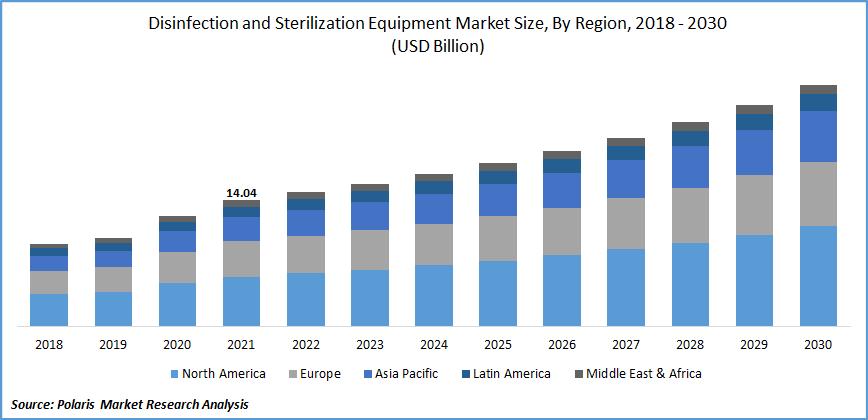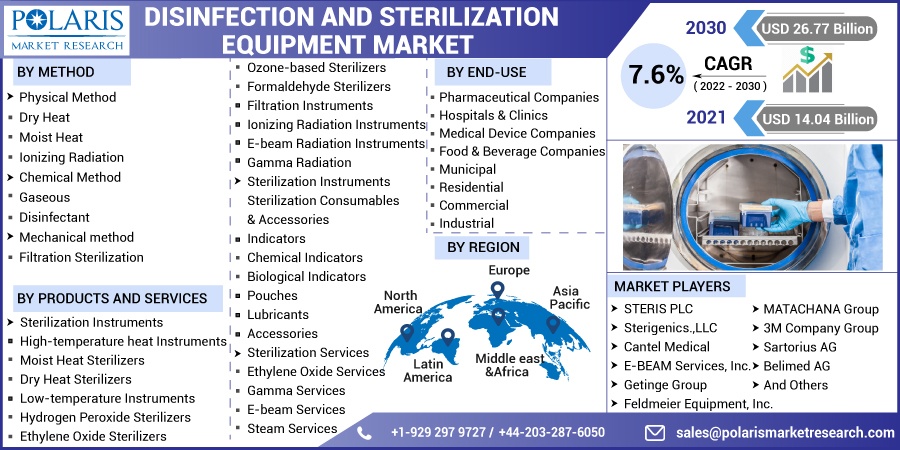
Disinfection and Sterilization Equipment Market Share, Size, Trends, Industry Analysis Report, By Methods (Physical Method, Chemical Method, Mechanical Method); By Products & Services; By End-Use; By Region; Segment Forecast, 2022 - 2030
- Published Date:Jul-2022
- Pages: 112
- Format: PDF
- Report ID: PM1313
- Base Year: 2021
- Historical Data: 2018-2020
Report Outlook
The global disinfection and sterilization equipment market size was valued at USD 14.04 billion in 2021 and is expected at a CAGR of 7.6% during the forecast period. Key factors responsible for the disinfection and sterilization equipment market growth include the surge in cases of hospital and healthcare-associated infections, the rising need for effective measures to counter infections in healthcare settings, and innovations in disinfection technologies.

Know more about this report: Request for sample pages
Moreover, the rise in the number of surgeries in medical facilities is one of the main considerations adding to showcase the disinfection and sterilization equipment market development. Maintaining proper cleanliness and disinfection is important for an infection-free environment in hospitals and clinics.
As per the CDC, each year, up to 1.7 Mn hospitalized in-patients in the U.S acquire healthcare-associated infections, and more than 98,000 of such people (1 out of 17) die by acquiring HCAIs. Furthermore, 32% of all hospital-acquired infections (HAIs) in the nation are urinary tract contaminations, 22% are surgical-site infections, 15% are lung (pneumonia) diseases, and 14% are circulation system contaminations; these are some of the factors responsible for the adoption of effective disinfection equipment for the reduction of worldwide infection cases.
The COVID-19 outbreak took the disinfection equipment market to another level. There was an immense and steady demand for effectively sterilized cutting-edge medical care systems and infrastructure for treating the covid-19 infected patients in the hospitals and clinics. To satisfy this rising need all around the world, many organizations have approached to fulfil the demand and produce manageable products like masks and PPE kits to decrease the spread of COVID-19.

Know more about this report: Request for sample pages
Industry Dynamics
Growth Drivers
The rising numbers of HAIs (Hospital-acquired Infections) and HCAIs (healthcare-acquired infections) because of the unavailability of proper disinfection measures are one of the key components expected to impel disinfection and sterilization equipment market development during the forecast period.
Proper disinfection is expected for the various equipment utilized in the hospitals and clinics as they help in reducing the chances of contamination spread. The rising pervasiveness of chronic conditions has fundamentally expanded the hospital admission rate. Covers, sterile liquids, and medical equipment are some of the fundamental necessities in clinics and healthcare facilities.
Accordingly, for the treatment, disinfection and sterilized equipment and surgical tools are required, as they decrease the risk of infection transmission among patients and further develop care delivery. Subsequently, the rising predominance of persistent infections is supposed to affect the disinfection and sterilization equipment market during the estimated time frame.
Report Segmentation
The market is primarily segmented based on method, products and services, end-use, and region.
|
By Method |
By Products and Services |
By End-Use |
By Region |
|
|
|
|
Know more about this report: Request for sample pages
Physical Disinfection Method to Hold the Largest Market Share During the Forecast Period
The physical disinfection procedure includes the effective use of non-toxic liquids, fumes, or gases, and it is considered one of the modest, fast, and compelling sterilization methods for killing and eliminating possibly all types of microorganisms and spores.
Hospitals and clinics majorly utilize moist heat to sterile the clinical equipment and instruments, like surgical blades and scissors. Dental specialists additionally regularly utilize this disinfection strategy to clean their dental surgical equipment.
Sterilization Segment is Expected to Witness Biggest Growth During the Forecast Period
Based on products and services, the high-temperature heat sterilization instruments segment is expected to register the highest growth rate over the study period. The high-temperature heat sterilizers are mainly as toxic chemicals are not required during the sterilization process.
The biggest disinfection equipment market share of the high-temperature heat sterilization instruments segment is supported by the effectiveness of the equipment in sterilizing reusable instruments and surgical and other materials.
Low-temperature sterilizers held one of the fastest segments during the forecast period. This method includes the use of Ethylene Oxide (EtO), hydrogen peroxide gas, and utilizing other fluid synthetic substances. The methods have been developing throughout the ten years, attributable to the changing medical services climate and complex advancements. Also, the utilization of costly, complex, and sensitive clinical instruments that are challenging to clean are one of the restraining factors for market development.
Hospitals & Clinics Sector is Expected to Hold the Significant Revenue Share
Based on the end-use, the hospitals and clinics fragment is expected to represent one of the biggest portions during the forecast period. The growth of this fragment can be credited to the rising rate of HAIs, the increasing number of hospitals and clinics in Asian nations, the rising number of surgeries performed every year, and the rising government initiatives to diagnose HAIs.
The municipal fragment overwhelms the market and is supposed to maintain steady growth during the forecast period because of the introduction of various advanced technologies for the treatment of drinking water and sewage water in developed economies. Metropolitan treatment plants have expanded their inclination towards advanced water treatment technology over traditional technologies since they are more productive and safe for the ecosystem.
The Demand in North America is Expected to Witness Significant Growth
North America is expected to rule the market during the forecast period. The huge market share of the region can be attributed to reimbursement policies formulated by the government. Several administrative strategies in regards to the delivery of safe and quality medical care services, for example, the presence of the Patient Protection and Affordable Care Act, additionally command the utilization of sterilization equipment in clinics and facilities, are one of the factors expected to fuel the disinfection equipment market development over the forecast period.
The market in the Asia Pacific region is supposed to observe an impressive development rate due to the factors like the rising requirement for controlling medical clinic-acquired contaminations and developing interest in non-dispensable clinical gadgets. The government is making continuous efforts to increase awareness about cleanliness in hospitals and clinics.
Competitive Insight
The key market players continually participate in different formative systems like association, coordinated efforts, new item dispatches, and acquisitions to reinforce their market position and gain market share.
Some of the major players operating the disinfection and sterilization equipment market include STERIS PLC; Sterigenics; Cantel Medical; E-BEAM Services; Fortive, Getinge, MATACHANA, Feldmeier Equipment, 3M Company, Sartorius, Belimed, Fortive Corp, Boekel Scientific, others.
Key Developments
- In June 2021, STERIS gained Cantel, through a US subsidiary to enhance its vast portfolio of cleansing instruments and services.
- In October 2020, Getinge introduced “Solsus 66 steam sanitizer” for the medical clinics with expanded limit and the operational reliability.
- In August 2021, Aurabeat introduced anti- of COVID class 2 device for SARS-COV-2 disinfection, in India.
- In February 2021, Xech introduced stethoscope sanitizer, “Xech Sterostet”, in India.
- In April 2020, FDA endorsed the utilization of Steris V-PRO 1 Plus, and maX low-temperature cleansing frameworks for purification of around 750,000 N95 respirators and comparative covers every day in clinics utilized for treating COVID-19 patients. This might expand the altruism of the organization.
- In April 2019, Fortive finished the obtaining of Advanced Sterilization Products business section from Johnson and Johnson, which likewise incorporates STERRAD Sterilization System. In this manner, disease anticipation related item portfolio would be showcased under Fortive.
Disinfection And Sterilization Equipment Market Report Scope
|
Report Attributes |
Details |
|
Market size value in 2021 |
USD 14.04 billion |
|
Revenue forecast in 2030 |
USD 26.77 billion |
|
CAGR |
7.6% from 2022 - 2030 |
|
Base year |
2021 |
|
Historical data |
2018 - 2020 |
|
Forecast period |
2022 - 2030 |
|
Quantitative units |
Revenue in USD billion and CAGR from 2022 to 2030 |
|
Segments covered |
By Method, By Products and Services, By End-Use, By Region |
|
Regional scope |
North America, Europe, Asia Pacific, Latin America, Middle East & Africa |
|
Key companies |
STERIS PLC; Sterigenics., LLC; Cantel Medical; E-BEAM Services, Inc., Getinge Group, MATACHANA Group, Feldmeier Equipment, Inc., 3M Company Group, Sartorius AG, Belimed AG, Fortive Corporation, others. |
